City Hall Monuments
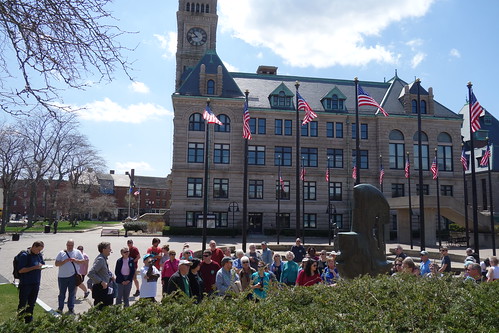
Last weekend was the City Hall Monuments tour which was given as part of ArtWeek. Seventy people came on Saturday’s tour and 20 on Sunday’s (when rain threatened). Many who couldn’t make the two tours have asked me to post my notes online so they can get an idea of what the tour covered. I have done that below as a rare departure from my normal Sunday morning Week in Review blog post. That will return next Sunday.
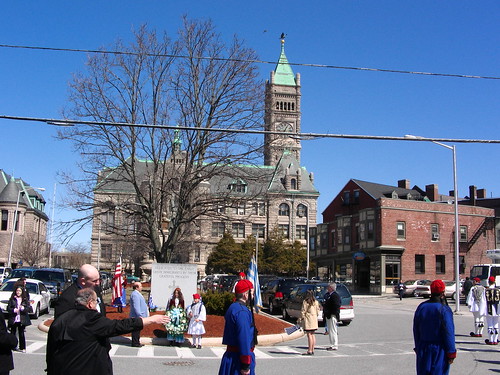
Greek Monument – “Dedicated to the early Greek immigrants by their grateful progency.” During the last decade of the nineteenth century, newcomers from Greece joined the stream of people from southern and central Europe flowing into Lowell. The Greeks went to work in the mills and settled in the Acre where their language, religion and culture thrived. By 1910, more than 20,000 Greeks lived in Lowell; the Byzantine-style Greek Orthodox Holy Trinity Church was dedicated in 1908.
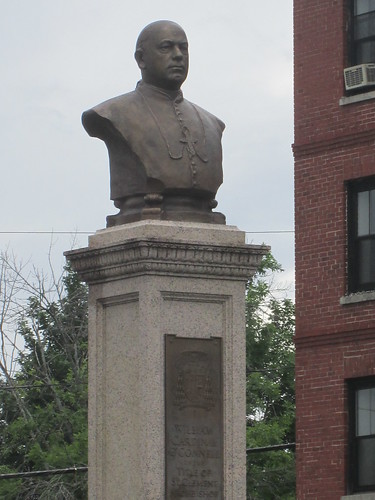
Cardinal O’Connell
Cardinal O’Connell – William Cardinal O’Connell, Archbishop of Boston. Born in Lowell to Irish immigrant parents, William Henry O’Connell (1859-1944) entered the priesthood after graduating from Boston College. He rose rapidly in the Catholic Church, becoming the second Archbishop of Boston in 1907 and a Cardinal in 1911. During his 36 years in charge of the Boston archdiocese, he oversaw the construction of numerous churches, schools and hospitals and became a force in Massachusetts politics. Known as “Gangplank Bill” because he was always photographed walking onto or off of a luxury liner for his many trips to Rome.
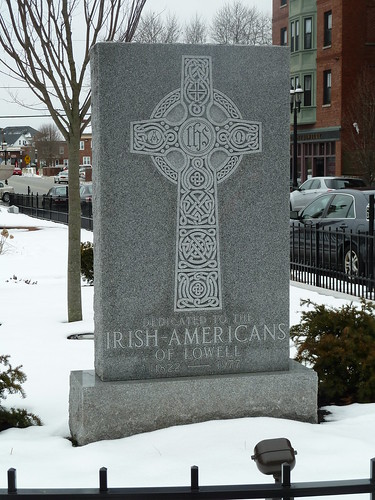
Irish Monument – Dedicated to the Irish Americans of Lowell. 1822-1977. The Irish Community of Lowell was the first ethnic group to inhabit this area. In 1822, Hugh Cummiskey, an immigrant from Northern Ireland, led the first group of Irish laborers to Lowell to help dig the canals and build the mills. The 1855 state census identified 10,369 native-born Irish out of a total population of 37,553. Another major migration in the 1890s further increased the number of Irish in Lowell.
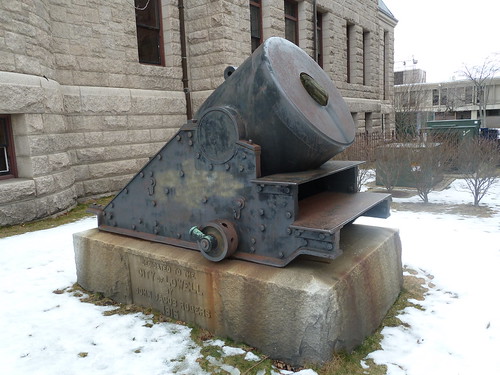
Civil War Mortar – dedicated to the City of Lowell by John Jacob Rogers, 1915. In September 1913, Rogers wrote to Mayor O’Donnell to say this 13 inch, nine ton mortar was deemed surplus by the Navy (it was at the Portsmouth Naval Shipyard). “It occurred to me the mortar would be highly ornamental and appropriate for one of our Lowell commons or parks.” Originally on North Common. In 1915, veterans group wanted this and the Spanish gun located between City Hall and Memorial Hall along with a similar artifact from the Revolutionary War as “reminders of the three wars whose resultant effects have had so much to do with making our Country honored among the nations of the World. Rogers served in Congress from 1912 until his death in1925. He was succeeded by wife, Edith Nourse Rogers, who served until her death in 1960.
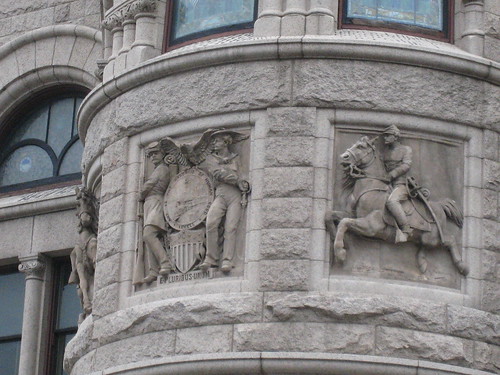
Memorial Hall & Pollard Memorial Library – Lowell native and MIT trained architect, Frederick Stickney (1853-1918) was selected over dozens of others in 1891 to design the city’s new library which would be known as Memorial Hall in honor of those who had died during the Civil War. Jack Kerouac maintained that his real education came at the city library which he described in his novel Doctor Sax: “All the night before I’ve been dreaming of books – I’m standing in the children’s library in the basement, rows of glazed brown books are in front of me, I reach out and open one – my soul thrills to touch the soft used meaty pages covered with avidities of reading – at last, at last, I’m opening the magic brown book.” In 1981 the building was named the Pollard Memorial Library for World War II veteran and longtime city councilor and mayor Samuel Pollard.
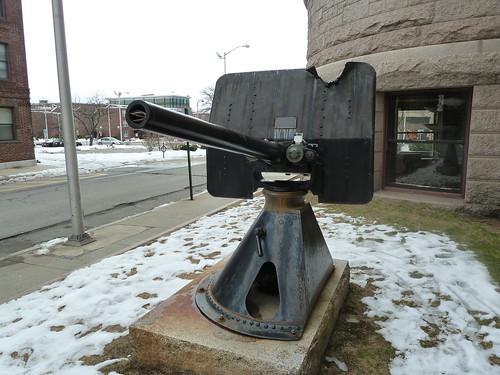
Vizcaya Deck Gun Taken from the Spanish Cruiser Vizcaya after the Naval Battle at Santiago, July 3, 1898, presented by Lowell-native Charles H. Allen, Assistant Secretary of the Navy, June 1899. After a term in Congress, Charles Herbert Allen (1848-1934) returned to Lowell to manage his father’s lumber company. When the Spanish American War began, Allen became Assistant Secretary of the Navy and then the first U.S. governor of Puerto Rico. He subsequently returned to Lowell and devoted himself to painting and gardening. His home, The Allen House, is on UML South Campus. Also at the battle of Santiago, Lowell-native, George Charrette of the U.S. Navy was awarded the Medal of Honor for heroism in battle while serving on the USS Merrimack.
Fire Department Monument – dedicated on June 5, 1977 in honor of all deceased Lowell Firefighters. Outdoor memorial mass on the 2nd Sunday of June each year. Inscription reads “Dedicated to the memory of the firefighters of Lowell, faithful and courageous in their service to the public.” Kelly Page was the most recent Lowell Firefighter to die in the line of duty.
JFK Civic Center – June 1968 council voted 6-3 to borrow $3.4mil to build this symbol of the New Lowell. Replaced police station, fire station and provided additional office space. 1966 Sun editorial “If there is to be a new Lowell then we need this Civic Center.”
Lithuanian Monument – In Honor of the Lithuanians who came to Lowell. Hundreds of Lithuanians arrived in Lowell in the years before World War One. They sought work in the mills and established a Lithuanian church, St. Joseph’s, on Rogers Street. They also established a Grand Duke of Lithuania Vytautas (DLKV) Club to help perpetuate Lithuanian culture at civic celebrations, festivals, and parades.
Italia Monument – by Mico Kaufman. Dedicated on October 12, 1987. “Images of Italy as I lovingly remembered.” Mico Kaufman was born on January 3, 1924 in Buzeu, Romania, where he grew up with his parents, Adele and Herman Kaufman and two siblings, sister Liza and brother Ionel. A self-taught artist, he learned to draw and sculpt through experimentation with different mediums. At the age of 16, he created his first formal project, a nude female figure whittled from his uncle’s broken cane. His mother’s dream was that Kaufman become a concert violinist to follow in the footsteps of his famous cousin, violinist Louis Kaufman, but sculpting was Kaufman’s first love. As he prepared for a career in the arts, World War II interrupted his studies, preventing him from finishing high school. With the escalation of the Anti-Semitic movement throughout Europe and the persecution of Jews in Romania, Kaufman eventually found himself spending three years digging trenches in a Nazi concentration camp, until his release at the age of 21. In 1947, at the end of the war, he left Romania for Italy where he began his formal art training in sculpture at the Academy of Fine Arts in Rome. Came to America at age 24.
John Green Monument – Inscription reads “John B. Green, 1931-1993, A people person who cared and left Lowell a better place for all of us.” Green was a key player in the Regatta Festival Committee along with Pauline Golec, Richard Taffe and Zenny Speronis. While his Speare House restaurant on Lowell’s Pawtucket Boulevard was a great success, owner Zenny Speronis felt the adjacent Merrimack River was an underutilized civic resource. Gathering an eclectic mix of activists from Lowell’s business and ethnic communities, he formed the Lowell Regatta Festival Committee which held twice yearly festivals on the riverbank and in downtown. Speronis and fellow Regatta organizers Golec, Green and Taffe paved the way for the Lowell Folk Festival.
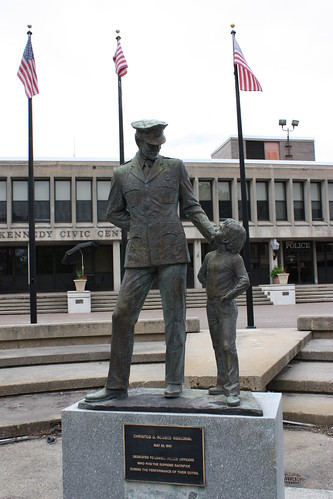
Rouses Monument – Christos G. Rouses Memorial, May 22, 1980, “Dedicated to Lowell Police Officers who paid the supreme sacrifice during the performance of their duties.” Sculpted by Mico Kaufman. On the afternoon of November 17, 1978, Officer Chris Rouses (1925-1978), a well-liked and respected 23 year veteran of the Lowell Police Department, answered a silent alarm at Limby’s Pharmacy on Branch Street. Confronting an armed robber, Officer Rouses was fatally shot. Other officers shot and killed his assailant. Officer Rouses, who left a wife and three children, was the fourth Lowell Police officer killed in the line of duty: Patrick F. Leavitt who died on December 18, 1941, George F. A. Pearsall who died on April 24, 1957, John Joseph Winn who died on May 31, 1971, and Christos G. Rouses who died on November 17, 1978. A second marker on the site memorializes officers Steve Smith, John Sullivan, Dave Seamans, and Donald Brill who in October 1996 died in a plane crash in Canada.
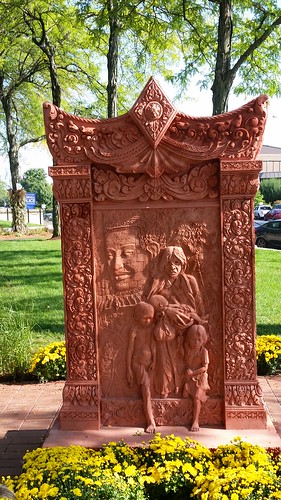
Cambodian Monument (NEW in 2017). “This monument is dedicated to the two million Cambodian people who suffered and died at the hands of the Khmer Rouge Regime. We honor all survivors of this genocide whose resiliency led them to find a new beginning in Lowell, strengthening through tradition, perseverance and love.” After the fall of Vietnam in 1975, the Khmer Rouge came to power in Cambodia and killed more than 2 million Cambodian people. Many fled the country to refugee camps in Thailand and the Philippines. Eventually, the US Congress let many of these refugees come to the United States where they were initially placed in settlement sites around the country. Lowell was one such site and had an initial settlement of just a few hundred refugees in the early 1980s. However, by 1986, the booming economy of the Massachusetts Miracle and recession in much of the rest of the country drew a secondary migration from across the United States, giving Lowell the second largest population of Southeast Asian residents in the entire country.
Lowell City Hall
Constructed in 1893 at a cost of $300,000 on land purchased from the Merrimack Manufacturing Company, Lowell City Hall is an ornate building filled with oak and marble. Its 360 foot clock tower is visible from all sections of the city.
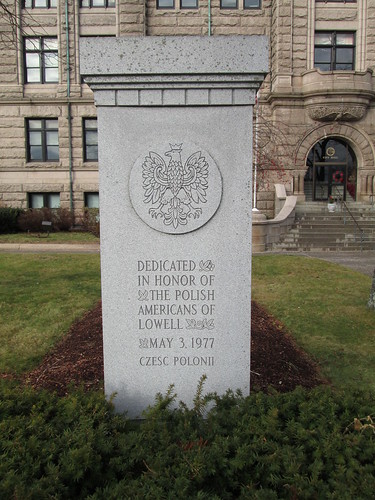
Polish Monument – “Dedicated in honor of the Polish Americans of Lowell, May 3, 1977.” By 1918, more than 5,000 Polish immigrants had come to Lowell where they settled in Polish-speaking clusters in neighborhoods such as Centralville from which they could walk across the Merrimack River bridges to work in the mills. Catholic churches with liturgies in Polish and social clubs like Dom Polski have kept Polish culture alive in Lowell.
Portuguese Monument – “In honor of the heritage and contributions of the Portuguese Community to the City of Lowell, June 10, 2009.” Portuguese immigrants first came to Lowell in the 1890s and early 1900s, with most settling in the Back Central neighborhood where they established St. Anthony’s, a Catholic parish which continues to hold liturgies in Portuguese, along with social clubs and small businesses. Enhanced by more recent arrivals from the Azores, the Portuguese community of Lowell actively celebrates its language and culture throughout the year. Portuguese from the Azores had long worked on whaling ships and settled in New Bedford. Starting around 1890, Portuguese started coming to Lowell to find work in the mills. They established a Catholic church on Central Street near the corner of Floyd Street. By 1916, Portuguese settlers in Lowell numbered over 3,000.
Franco-American Monument – “In honor of the Franco-Americans of Lowell, Mass, June 24, 1974.” Bell by the William Blake & Co. A post-Civil War boom caused Lowell’s mills to send agents to Quebec in search of low-cost labor. The industriousness of the thousands of Franco-Americans who came contributed to the city’s economic expansion while their commitment to their religion and culture enriched the city’s soul. Many of Lowell’s French Canadians settled in Little Canada, a neighborhood of densely packed, wood frame tenements near the mills. Many remember Little Canada as a proud, vibrant community and regret its 1960s demolition in the name of urban renewal.
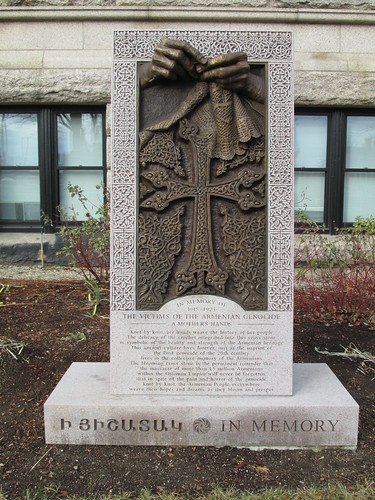
Armenian Monument – “In memory of 1915-1923 the victims of the Armenian Genocide.” Drawn by employment opportunities after having been driven from their homeland by political persecution and massacres, many Armenians came to Lowell during the early decades of the twentieth century with most settling in the Chapel Hill neighborhood. Saints Vartanantz Armenian Apostolic Church opened on Lawrence Street in 1916 and played an important role for the Armenian community of Massachusetts by providing religious, social, and cultural services. With funds raised by the Merrimack Valley Armenian Monument Committee, a bronze-and-granite Armenian Genocide Monument was unveiled on the grounds of Lowell City Hall in May 2014.
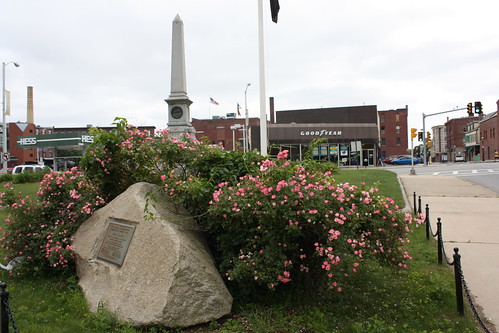
Donald Arcand Monument
Donald Arcand – Arcand Drive Born in 1946, Donald Arcand lived on Ford Street which was in Little Canada and where Fr Morissette Blvd is now. Arcand graduated St Joseph’s High School in 1963 and volunteered for the Army. He was trained as an Infantryman but was assigned to an aviation unit where he served as a door gunner on a UH-1 Huey helicopter. On September 1, 1965, his helicopter was hit by ground fire and exploded in midair, killing all aboard. His funeral took place a week later at St Jean Baptiste Church and he was buried in St Joseph’s Cemetery. On May 25, 1969, Arcand Drive was dedicated immediately following the Memorial Day parade.
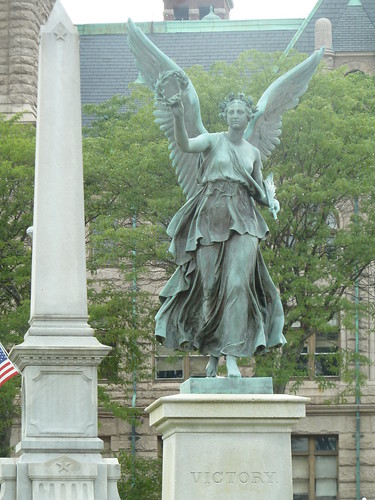
Ladd & Whitney – In November 1860, Abraham Lincoln was elected president. By the end of January 1861, seven southern states had seceded from the Union. In March 1861, Lincoln took office. In April 1861, Lincoln sought to resupply the US Army garrison at Fort Sumter which was located in the harbor of Charleston, South Carolina. The South Carolina government, which had seceded, demanded the surrender of the Fort. When that was not forthcoming, the South Carolina militia began a bombardment of the fort on Friday, April 12, 1861. The fort surrendered the next day after 36 hours of bombardment. On April 14, Lincoln called for 75,000 volunteer troops from the north to suppress the rebellion. On Tuesday, April 16, the Lowell-based Sixth Massachusetts Volunteer Infantry formed up and departed Lowell by train, bound for Washington. While passing through Baltimore on April 19, the unit was attacked by a pro-Southern mob which fired upon the troops, killing four of them – Luther Ladd, Addison Whitney, Sumner Needham and Charles Taylor. Ladd and Whitney were two young mill workers from Lowell. The city and the Commonwealth constructed a monument in their memory since they were considered to be the first soldiers killed by hostile fire in the American Civil War. The monument was to be dedicated on April 19, 1865 but the assassination of President Lincoln a few days earlier delayed the dedication ceremony to June 17, 1865, Bunker Hill Day.
Victory – “A Gift to the People of Lowell from James C. Ayer. Erected July 4, 1867.” A draped woman with wings holding the laurel wreath of victory and the harvest sheaf representing peace. It was sculpted by Christian Daniel Rauch, the foremost German sculptor of the 19th century, for the king of Bavaria. The original of bronze stands in front of the king’s palace in Munich. While traveling in Europe, James C. Ayer saw the statue and thought of purchasing a duplicate and presenting it to the city of Lowell. The day of its dedication there was a big ceremony attended by 20,000 people. James C. Ayer (1819-1878) came to Lowell at age 13 to work in an apothecary. Opening his own drug store in 1841, Ayer began concocting his own medicines and through the shrewd use of advertising built the most successful patent medicine company in America. The $20 million fortune derived from patent medicine sales financed Ayer’s diversification into mill ownership and his many acts of civic generosity.
Our next walking tours come next weekend with the Spring Lowell Cemetery tours: Friday, May 11, 2018 at 1 pm and Saturday, May 12, 2018, at 10 am. Both begin at the cemetery’s Lawrence Street gate. Please check our “Upcoming Events” page for other Lowell History tours this summer.